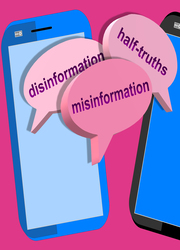How to Teach Your Kids About Misinformation Online
The digital landscape offers a wealth of knowledge and challenges. As a parent, you’re responsible for ensuring your children discern the real from the fake. Arming them with the right tools to challenge online misinformation is more crucial than ever. Here are some actionable ways to help guide your children.
1. Teach Them to Question Everything
Teaching kids to be discerning online readers starts with fostering a questioning mindset.
Encourage them to probe deeper when they encounter new information. Rather than taking everything they read as the truth, they should challenge it.
Ask them to consider, “Is this information up to date? Can I trust this source? Who wrote this and why did they write it?” This approach aligns with the C.R.A.P. (Currency, Reliability, Authority and Perspective) Detection Test — a straightforward method to assess online content’s credibility.
2. Instruct How to Spot Fake Social Media Accounts
Misinformation often finds its way to you through deceptive social media accounts, so teach your children to differentiate genuine profiles from fake ones. Tell them to examine profile pictures closely. A generic or stock image might be a sign of a fake account.
Next, encourage them to look at the account’s follower count in relation to its age. A user that’s only been active for a short time but boasts a large following can be suspicious.
Additionally, the content of the posts matters. Advise your children to read through several posts to determine if they seem genuine or are merely reposting sensational or controversial content without original thoughts. It’s also beneficial to check if the account interacts genuinely with followers, or if the comments seem automated or irrelevant.
3. Encourage Lateral Reading
Lateral reading involves actively seeking out multiple sources to validate or refute the information they come across. Instead of solely relying on one article or video, prompt your children to open new tabs and compare facts from different outlets. Dr. Joel Breakstone — director of the Stanford History Education Group — champions this method, especially when debunking fake news.
To make this practice a habit, you could set up a family fact-checking challenge. Whoever successfully debunks a piece of misinformation could earn a small reward. This makes the process engaging, and instills a sense of responsibility and skepticism that will serve them well in the digital age.
4. Train Them Look for Red Flags
When it comes to misinformation, the devil is often in the details. Take a lesson from the world of financial scams. Specific red flags can tip you off to a threat, such as spelling mistakes, public domain email addresses and unsolicited requests for personal information. These warning signs aren’t exclusive to financial scams and can be key indicators of fake news online.
How can you translate this into practical advice for your kids? First, teach them to scrutinize the language used in articles or social media posts or videos on platforms such as YouTube. If they read something online, tell them to look at the account that posted it. An account with no profile picture or description could be a scammer or a bot spreading misinformation. On social media, kids may receive private messages from accounts like this asking for personal information to enter a giveaway or saying they need to click a link.
Misinformation can come from any source, however. On social media, it’s common for news stories or popular trends to go viral without any verification. Advises your kids to be careful about repeating stories they hear online or trying popular trends that could impact their health. Tell them not to take advice from someone online who is not a professional.
5. Show How to Verify Information
Encourage your kids to adopt a mindset of healthy skepticism. This means questioning the information they encounter while remaining open to discovering the truth. It’s a delicate balance but an essential one.
Drill the importance of not taking any information at face value into your children, especially from social media or unfamiliar websites. Show them how to use reputable fact-checking websites like Snopes or FactCheck.org to confirm the validity of a news story or viral post. Also, teach them to consult multiple trusted sources for any information.
For example, if they read a news article making a significant claim, they should cross-reference it with other reputable outlets. This practice helps confirm the information and provides a more nuanced understanding of the topic.
6. Discuss Real-World Examples
When teaching your kids about misinformation, real-world examples prove invaluable. Instead of relying on hypothetical scenarios, turn to the digital content they interact with daily. Whether it’s a trending game, a viral TikTok video or a popular Instagram post, these platforms offer rich material for discussion. Encourage your kids to be internet skeptics and break down what they see and hear.
For instance, if they encounter a captivating YouTube video, prompt them to summarize its main points. Then, delve deeper by discussing the creator’s intentions. Was the video made to inform, entertain or persuade? Analyzing actual content helps children sharpen their critical-thinking skills and learn to discern the underlying motives in the vast sea of online information.
Equip Your Kids With Skills to Combat Misinformation
Don’t just warn your kids about the pitfalls of misinformation. Give them the tools to confront it head-on. Remember — a well-informed child doesn’t just passively consume information. They actively engage with it, question it and understand its impact. Start teaching your kids how to be savvy digital citizens today because an educated mind is the most effective weapon against misinformation.
 Author bio: Cora Gold is the Editor-in-Chief of women’s lifestyle magazine, Revivalist. She strives to live a happy and healthy life with her family by her side.
Author bio: Cora Gold is the Editor-in-Chief of women’s lifestyle magazine, Revivalist. She strives to live a happy and healthy life with her family by her side.
Follow Cora on Facebook and LinkedIn.





